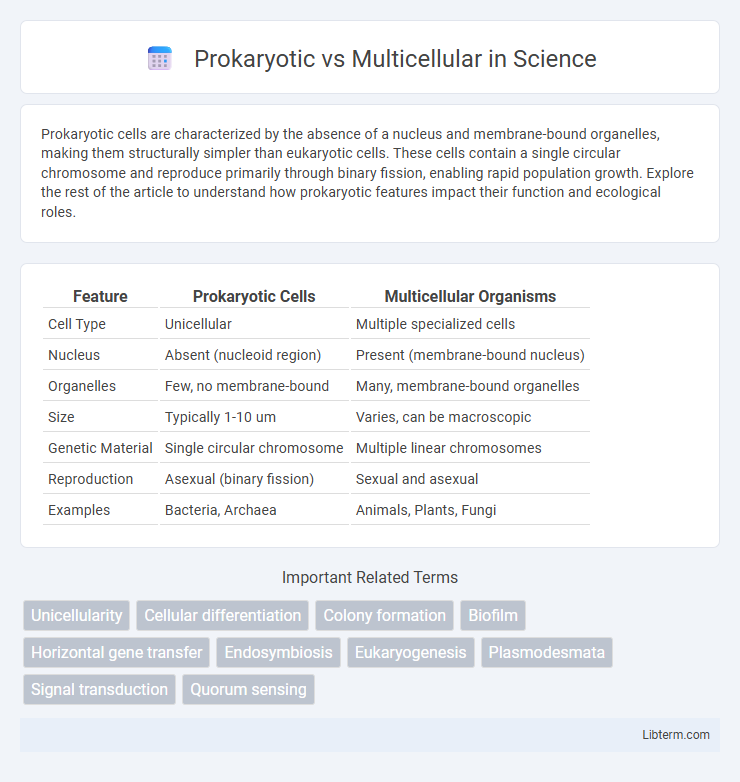Prokaryotic cells are characterized by the absence of a nucleus and membrane-bound organelles, making them structurally simpler than eukaryotic cells. These cells contain a single circular chromosome and reproduce primarily through binary fission, enabling rapid population growth. Explore the rest of the article to understand how prokaryotic features impact their function and ecological roles.
Table of Comparison
| Feature | Prokaryotic Cells | Multicellular Organisms |
|---|---|---|
| Cell Type | Unicellular | Multiple specialized cells |
| Nucleus | Absent (nucleoid region) | Present (membrane-bound nucleus) |
| Organelles | Few, no membrane-bound | Many, membrane-bound organelles |
| Size | Typically 1-10 um | Varies, can be macroscopic |
| Genetic Material | Single circular chromosome | Multiple linear chromosomes |
| Reproduction | Asexual (binary fission) | Sexual and asexual |
| Examples | Bacteria, Archaea | Animals, Plants, Fungi |
Introduction to Cellular Organization
Prokaryotic cells, such as bacteria and archaea, exhibit a simpler cellular organization lacking membrane-bound organelles and a defined nucleus. Multicellular organisms, including plants and animals, possess complex cellular structures with specialized cells organized into tissues and organs, allowing for advanced functions and coordination. This fundamental difference in cellular organization underpins the diversity of life forms and their biological processes.
Defining Prokaryotic Cells
Prokaryotic cells are unicellular organisms characterized by the absence of a membrane-bound nucleus and organelles, with genetic material freely floating in the cytoplasm. These cells are typically smaller and simpler than multicellular eukaryotic cells, enabling rapid growth and reproduction. Examples include bacteria and archaea, which thrive in diverse environments due to their streamlined cellular structure.
Understanding Multicellular Organisms
Multicellular organisms consist of specialized cells organized into tissues, organs, and systems that perform distinct biological functions, enabling greater complexity and adaptation. Unlike prokaryotic cells, which are unicellular and lack membrane-bound organelles, multicellular organisms rely on cellular differentiation and intercellular communication to maintain homeostasis and support growth. Studying the molecular mechanisms and genetic regulation in multicellular life forms enhances our understanding of development, disease processes, and evolutionary biology.
Key Structural Differences
Prokaryotic cells lack a nucleus and membrane-bound organelles, featuring a simple structure with a single circular DNA molecule located in the nucleoid, while multicellular eukaryotic organisms possess complex cells with a defined nucleus and specialized organelles like mitochondria and the endoplasmic reticulum. Prokaryotes are generally unicellular with a rigid cell wall made of peptidoglycan, whereas multicellular organisms exhibit cellular differentiation and organization into tissues with extracellular matrices. The size difference is significant, as prokaryotic cells are typically 0.1-5 micrometers in diameter, compared to eukaryotic cells that are usually 10-100 micrometers, supporting more complex metabolic processes and cellular functions.
Genetic Material and Organization
Prokaryotic cells contain a single, circular chromosome located in the nucleoid region without membrane-bound organelles, while multicellular eukaryotes have multiple linear chromosomes housed within a defined nucleus and organized into chromatin. Genetic material in prokaryotes is typically simpler, with plasmids providing additional genetic information, whereas multicellular organisms exhibit extensive gene regulation, allowing for cellular differentiation and complex tissue organization. This fundamental difference in genetic material storage and organization underpins the structural and functional complexity differences between single-celled prokaryotes and multicellular eukaryotes.
Modes of Reproduction
Prokaryotic organisms primarily reproduce asexually through binary fission, a simple and rapid cell division process resulting in genetically identical offspring. In contrast, multicellular organisms exhibit diverse reproductive modes, including sexual reproduction involving meiosis and fertilization, promoting genetic variation, and asexual reproduction methods such as budding, fragmentation, or vegetative propagation. The complexity of multicellular reproduction enables adaptation and evolution across varied environmental conditions.
Metabolic Diversity and Adaptations
Prokaryotic organisms exhibit remarkable metabolic diversity, including capabilities like nitrogen fixation, methanogenesis, and anaerobic respiration, enabling survival in extreme environments. Multicellular organisms rely more on specialized cell types and metabolic pathways, often dependent on oxygen and stable environments for energy production. Adaptations in prokaryotes include versatile enzyme systems and horizontal gene transfer, while multicellular life evolves complex tissue differentiation to optimize resource use and environmental responses.
Evolutionary Perspectives
Prokaryotic cells, representing some of the earliest life forms, illustrate fundamental evolutionary processes with their simple structures and rapid reproduction, enabling widespread adaptation in diverse environments. Multicellular organisms evolved from unicellular ancestors through increased cellular specialization and cooperation, leading to complex body plans and enhanced survival strategies. This transition marks a significant evolutionary milestone, highlighting the genetic innovations and selective pressures that drive complexity in life forms.
Ecological Roles and Importance
Prokaryotic organisms, including bacteria and archaea, play crucial ecological roles in nutrient cycling, such as nitrogen fixation and decomposition, sustaining ecosystems by maintaining soil fertility and water quality. Multicellular organisms, ranging from plants to animals, contribute to ecosystem stability through complex food webs, habitat formation, and pollination services. Both groups are essential for ecosystem functioning, with prokaryotes driving biochemical processes and multicellular life supporting biodiversity and ecological interactions.
Summary Table: Prokaryotic vs Multicellular
Prokaryotic cells are unicellular organisms lacking a nucleus and membrane-bound organelles, typically found in bacteria and archaea, while multicellular organisms consist of multiple specialized cells with complex structures including a defined nucleus and organelles. Prokaryotes reproduce primarily through binary fission, whereas multicellular organisms exhibit sexual or asexual reproduction with differentiation of cell types supporting various functions. The size of prokaryotic cells generally ranges from 0.1 to 5 micrometers, compared to larger multicellular cells, enabling diverse organizational complexity in multicellular life forms.
Prokaryotic Infographic

 libterm.com
libterm.com